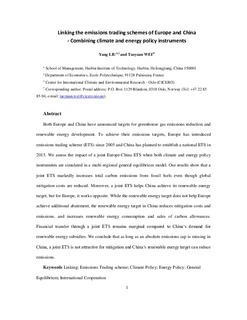Linking the emissions trading schemes of Europe and China - Combining climate and energy policy instruments
Journal article, Peer reviewed
Submitted version
Permanent lenke
http://hdl.handle.net/11250/2465563Utgivelsesdato
2014Metadata
Vis full innførselSamlinger
- Journal articles [478]
Originalversjon
Mitigation and Adaptation Strategies for Global Change. 2014, 21 (2), 135-151. 10.1007/s11027-014-9580-5Sammendrag
Both Europe and China have announced targets for greenhouse gas emissions reduction and renewable energy development. To achieve their emissions targets, Europe has introduced emissions trading scheme (ETS) since 2005 and China has planned to establish a national ETS in 2015. We assess the impact of a joint Europe-China ETS when both climate and energy policy instruments are simulated in a multiregional general equilibrium model. Our results show that a joint ETS markedly increases total carbon emissions from fossil fuels even though global mitigation costs are reduced. Moreover, a joint ETS helps China achieve its renewable energy target, but for Europe, it works opposite. While the renewable energy target does not help Europe achieve additional abatement, the renewable energy target in China reduces mitigation costs and emissions, and increases renewable energy consumption and sales of carbon allowances. Financial transfer through a joint ETS remains marginal compared to China’s demand for renewable energy subsidies. We conclude that as long as an absolute emissions cap is missing in China, a joint ETS is not attractive for mitigation and China’s renewable energy target can reduce emissions.
